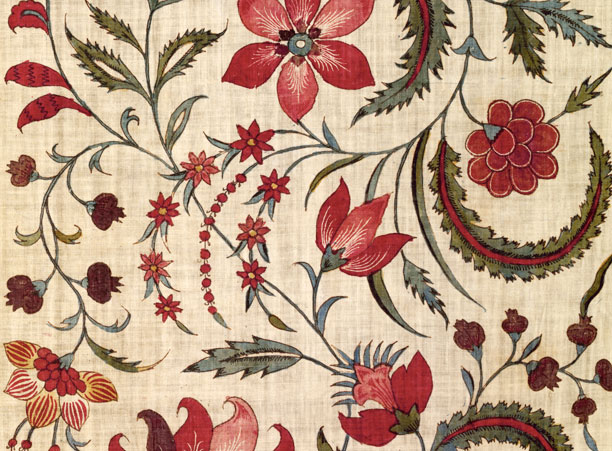When you first hear that her entire senior year was devoted to the study of British fabric design — specifically, chintz — you might assume that Meredyth Winter ’11 spent weeks and months poring over very particular art history texts and visiting specialized museums and collections.
Your assumption wouldn’t be wrong — but that’s only a small part of the remarkable story of this year’s Fenwick Scholar at Holy Cross.
In fact, Winter’s original Fenwick research spans centuries, continents, and disciplines.
She studied India’s dying and manufacturing technology in the 17th century — the printing and hand-painting techniques that created chintz. Incorrectly considered by many to be prototypically British in design and invention, chintz actually has its roots in India. As part of her research, Winter gained rare access to museum storerooms in London and Paris to explore fabrics and records. She incorporated trading routes between India and England into her research, exploring the economics of the day as well as the soaring popularity of design and the legal precedent that for a time banned imported chintz.
She conducted numerous visual analyses of patterns and fabric samples, comparing, for instance, the patterns from 18th century India with the work of 19th century British artists such as William Morris.
The yearlong study fueled her passion for art history.
“Art history is an ever-evolving discipline,” she says. “It’s fascinating to me to think that since the 1950s, the theory has been that the British East India Company sent patterns to India to be manufactured into chintz, and that assumption has been more or less upheld since. We need to look further back, before chintz became popular, to where the line between Indian and British designs was blurred. Only then can we ask, How did it become popular? How did it shape the development of fabric design?”
These questions began percolating for Winter during her junior year spent in Dijon, France, which included trips to Victorian and Albert Museum, which has an extensive collection of Indian textiles.
Winter, of Kansas City, received the Fenwick Scholar Award at the end of her junior year after a rigorous review process. The Fenwick Scholar Award is one of the College’s oldest and most prestigious academic distinctions. The recipient, selected on the basis of a proposal by a committee including the president and vice president for academic affairs and dean, designs a program of independent study and research, with the consultation of one or more faculty members. At the end of the academic year, the Fenwick Scholar makes a public presentation to showcase the project. The award is named in honor of the late Bishop Benedict J. Fenwick, S.J., the founder of Holy Cross.
Working with advisors Mika Natif, visiting assistant professor of visual arts, and Susan Rodgers, professor and chair of anthropology, Winter designed her course of study and spent three weeks in the fall of 2010 in London and Paris doing original research.
“Professors Natif and Rodgers were instrumental in sharing their contacts with me, connecting me with museum professionals and experts and helping me get access to non-public collections.”
Also, with the assistance of Roger Hankins, director of the Cantor Art Gallery, she also developed an exhibit of chintz patterns from 1550 to 1900 on display on the fourth floor of Fenwick Hall.
A member of the College Honors Program and an art history major, Winter has been active in the Student Advisory Committee for the visual arts department.
Winter’s public lecture titled “InConspicuous Consumption: Understanding the Role of Indian Chintz In Shaping British Fabric Design,” opens the College’s 2011 Academic Conference.
After graduation, Winter will head to New York City. “I will be pursuing a master’s degree in decorative arts, design history, and material culture at the Bard Graduate Center, where I will also have the opportunity to get curatorial experience in their gallery.”

Fenwick Scholar Focuses On New Understanding of Familiar Fabric
Passion for art history and unique faculty mentoring lead to discovery
Read Time
3 Minutes